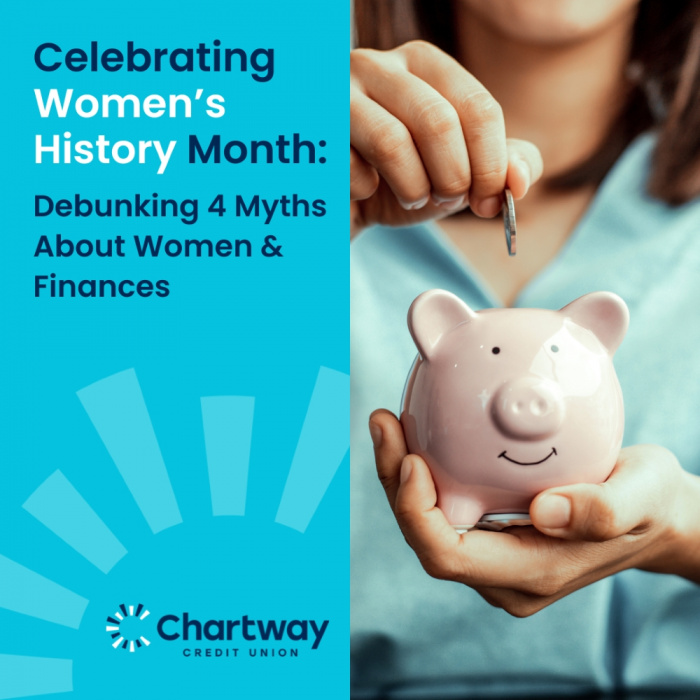Women's History Month is a time to recognize the significant contributions women have made throughout history, including in the field of finance. During times when women were often excluded from financial opportunities, there were many trailblazers who broke through barriers and paved the way for future generations.
In celebration of Women’s History Month, we want to honor the women who shattered the glass ceiling by addressing common misconceptions about women in the financial sphere. History, media, and popular culture have perpetuated several firmly held stereotypes about what women can and can’t do where money is concerned. So, we’re here to set the record straight by addressing and debunking four myths about women and money.
Myth #1: Women earn as much as men.
Reality: Women’s financial landscape has undoubtedly changed, but gender inequality in the workplace persists. In 2022, women earned 82 cents for every dollar men made, even when accounting for factors like education and experience that heavily influence hiring and compensation. Significant milestones have been achieved to advance women's financial and occupational opportunities, including The Equal Credit Opportunity Act that was signed and passed in 1974 and which prohibited discrimination in lending based on gender. Before this law was enacted, women couldn’t apply for credit, take on a mortgage, or open a bank account without their husband’s consent. In today’s world, women enjoy more financial freedom; but generalized assertions that women are being compensated at the same level as men who hold the same position are entirely false.
Myth #2: Women aren’t interested in investment planning.
Reality: On the contrary – women are actively engaged in investment planning. A 2021 Fidelity study found that 67% of women made investments outside of their retirement accounts, up from 44% in 2018. Despite the disproportionate impact of the pandemic, women are still financially preparing for a secure and stable future. More men invest overall, but women have a slight advantage with their investment returns. On average, women’s positive returns surpass men’s by 0.4% likely because, in considering long-term goals versus short-term gain, women are more likely to adopt a buy-and-hold strategy versus frequently trading, which can negatively affect performance over time.
Myth #3: Women spend money more frivolously than men.
Reality: Research shows that this stereotype is unfounded. A study by SmartAsset comparing single millennial men and women focused on spending across 11 categories and found that, overall, men earn more and spend more than women. Although expenses were comparable in categories like housing, utilities, and healthcare, one notable difference was that women spent $850 more annually on “reading and education” and $620 less than men in the category of “alcohol and tobacco.” The study also revealed that while women spend more in the category of “apparel and personal products” – a number likely inflated by the Pink Tax, which is a markup on merchandise marketed to women – men spend slightly more on dining out. Determining who does more non-essential spending depends entirely on the category.
Myth #4: Managing work and home life balance, women can have it all.
Reality: One of the prevalent messages that emerged from the Women’s Movement was that women don’t have to choose between fulfilling work or home life – they can have both! However, this prevalent message has proven unrealistic and detrimental. Increased awareness and research studies acknowledge how striving for this perfect work-life balance can leave women feeling depleted and distressed. A 2022 Women in the Workplace report by LeanIn.org revealed that among entry-level employees, women are about twice as likely to manage housework simultaneously; among employees in leadership roles, the gap is nearly twice as big. This imbalance can lead to burnout: 29% of women have considered reducing their hours, downshifting their roles, or quitting. This “women can have it all” notion has created the superwoman syndrome, which decreases the humanity of strong women and amplifies the perception that “boss women” are superior in everything they do, rarely showing emotion or weakness. Women are strong and incredibly multi-faceted, and women are humans with flaws. Focusing on progression instead of perfection leaves women with room to make mistakes and learn from them.
Four simple ways to rewrite or change these myths:
-
Myth #1: Continue to advocate for equal compensation and bridging the pay gap between men and women.
-
Myth #2: Diversify your investments. While a buy-and-hold strategy is proven effective, diversifying can help women grow their capital further.
-
Myth #3: This myth is unfounded, but it’s still a great idea to find ways to maximize your income by resisting the urge to justify unnecessary purchases. If you don't truly need it, avoid spending money you'll have to rationalize later.
-
Myth #4: Women can have it all; just because you can doesn’t mean you have to. Self-care is not a luxury; it’s a necessity. Make the time and create the space to prioritize yourself and your health without guilt. You’re no good to anyone when your life and health are in shambles, so take time to take care of you.
We’re grateful for the opportunity to educate you and debunk these common misconceptions with the help of our financial education partners at GreenPath. As we celebrate Women’s History Month, we encourage you to stop by one of our branches and connect with one of our Relationship Managers to learn more about your smart saving, spending, and borrowing as well as investment options for building your finances.
###

